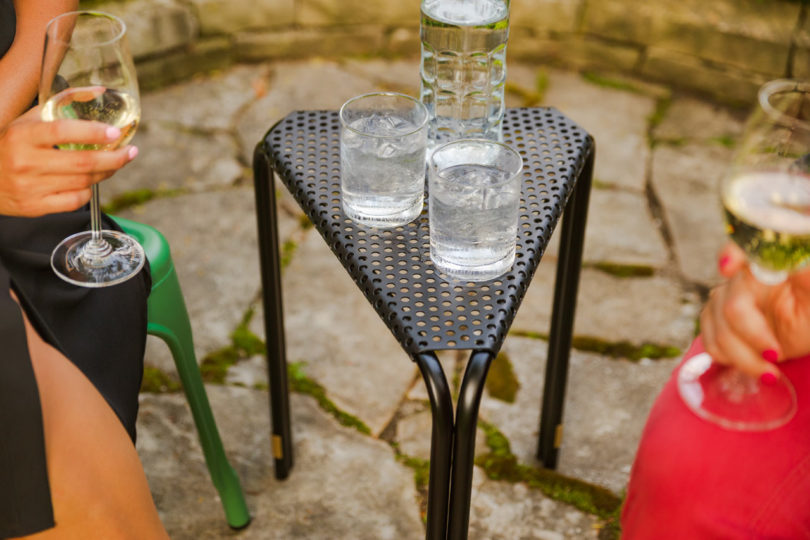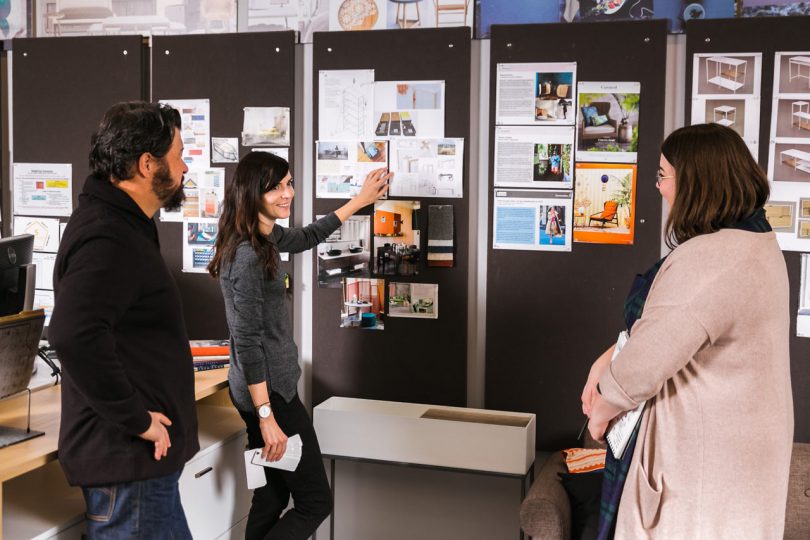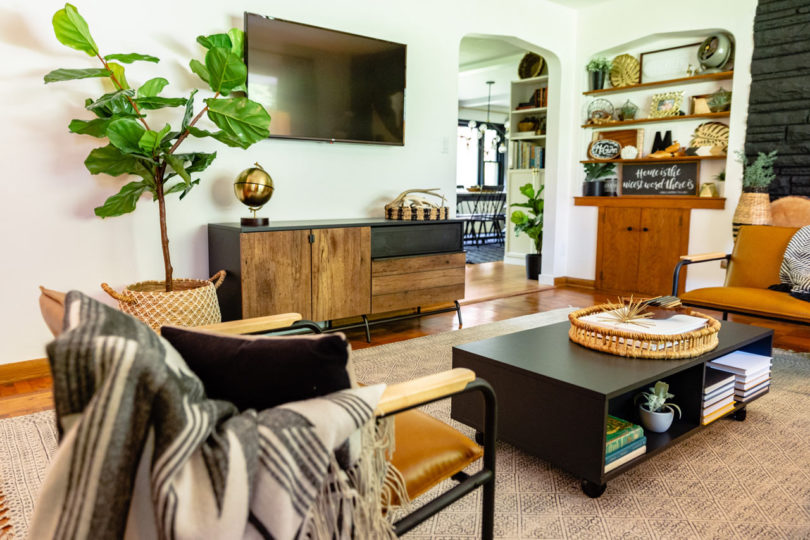Digital savvy millennials have been a growing influence on design, particularly because needs have changed over the years. Millennials are much more prone to move to new cities or from space to space rather than planting down roots for the long haul. That means designers have had to re-think their designs to make them more appealing, like being modular so they adapt to any space. They also tend to be more outspoken about what they want and oftentimes if they can’t find it, they figure out a way to create it which is why you see many of them drawn to become design professionals. To find out more, we reached out to furniture manufacturer Sauder and spoke with three millennial members of the Sauder design team who dove in and shared their thoughts on trends, millennials designing for themselves, and the future of design.
What’s a lifestyle or design trend/idea that you’re seeing (currently or forecasting), and how has Sauder incorporated it into the brand’s designs?
Rachel Whitaker, 31, principal furniture designer: Consumers today are living in an environment that’s constantly changing. Fewer things are permanent or defined. Life isn’t static, so we’re designing furniture that moves with us as our needs change.
We’re constantly evaluating how our consumers are living. We have a dedicated trend manager who assesses global lifestyle trends, cultural shifts and generational research to keep our finger on the pulse of the market, and a mobile, almost nomadic lifestyle is one trend we’re paying close attention to.
Consumers — millennials especially — have adapted a lifestyle that’s full of continuous movement and motion. This lifestyle is a result of the transition through different life stages — graduating college, moving to a new city, getting married, starting a family. It goes beyond physically moving between homes; it includes how people move and rearrange their space over time.
People are using space in their homes differently, with less rigidity and more adaptability. They’re shifting their priorities — turning what once was a designated space, like a formal dining room, into a multifunctional home office and hobby room that can someday transition into a kids’ playroom. More people are considering “income rooms” that might be rented out as a separate living space or used as a flat for aging parents. They’re moving life outdoors, swapping indoor square footage for flexible, outdoor living and gathering spaces to relax and entertain.

Boulevard Café Collection Triangle Side Table
We’re bringing these mobile, adaptable philosophies to life in the Boulevard Café Collection. This collection has a refined coffee shop aesthetic, which speaks to the values of community and collective living and gathering spaces. The pieces inspire movement through minimal use of materials for lighter weight, intentionally petite scale for smaller spaces and with the addition of casters. Several of the pieces, like the Dining Table and Triangular Side Table, can move from indoors to out depending on function and need, season or simply time of day. The furniture is nomadic, just like the lifestyle.
Angelo Hernandez Martinez, 32, furniture designer: Consumer expectations are higher than ever before — for style, for affordability, and now for versatility. Our furniture must meet these requirements while also answering: How responsive is it to my needs over time?
As Rachel mentioned, everyone is moving through their own lifestyle cadence. Some people are renting temporarily after relocating for a job. Others are straight out of college and might have limited resources to purchase things they want long term. Regardless of the life stage, consumers want to be in charge of their own space — not just today, but also several years down the road, too.
Consider the idea of household “hacks.” At its core, this concept comes from consumers’ demand to customize, personalize and make a product work for them in new ways throughout the home. If consumers can envision a piece serving multiple functions, they will make the investment.
In our design process, we’re constantly evaluating: How can we make it more useful? How would this transition from the bedroom to the living room? Could this design be used indoor and outdoor? Can it work in differently styled rooms? Once it’s outgrown its initial purpose, where does it fit and function next?
Our response at Sauder is designing pieces like the Anda Norr Credenza (available September 2018). This piece is designed as two cabinets. Together, the cabinets form a 72-inch credenza for entertainment use. Separated, the pieces become two complimentary storage cabinets. Use one cabinet in the entryway and another in the office, or put both together in the living room.
The Anda Norr Coffee Table is another example of adaptability within a piece. A sliding door on top reveals hanging file storage for an office or a place to store blankets or board games in a den, and we’ve even received comments that it’s a perfect turntable stand with room for record storage. Its function is truly dictated by its placement in a room.
Nicole Paparelli, 24, furniture designer: What once might have seemed unconventional — mixing varying shades of woodgrains or pairing silhouettes in different styles — is not only comfortable today but desired. People are blending design aesthetics, being more carefree with color and designing spaces that are intentionally eclectic.
For years, the furniture industry has seen a shift away from consumers buying a suite of products. Instead of purchasing entire matching home collections, people are designing their homes with an eclectic mix of furniture. They’re being intentionally eclectic when inheriting pieces from family members, merging households with a partner or while curating pieces that reflect their style and preferences. People are seeking a curated look that says something about their personal style, and our wide assortment of nearly 50 collections help them achieve that look easily.
The Harvey Park Collection gives consumers the chance to incorporate old and new for that intentionally eclectic style. Its Midcentury Modern stylings make it easy to pair new items with vintage finds. The collection evokes a sense of warmth and familiarity with mixed materials and finishes and introduces playful color that is not intimidating to the consumer.
We’re addressing color for different comfort levels in our designs. Many of our colorful, trend-forward pieces are smaller scale and a lower price point, so it’s an easy, low-commitment decision that doesn’t take a lot of consideration. Unlike a sofa or dining table that you expect to be a staple and last for many years, we’re creating accent pieces that are less invasive and aren’t a significant investment so they can be swapped out if styles or trends change. Designing a space is full of emotional decisions, and we’re making it easy to feel good about adding in a pop of color or popular pattern.
We’ve added a line of colorful accent cabinets and tables to some of our top-selling heritage collections, like Barrister Lane, Harbor View and Palladia. It helps take the uncertainty out of mixing and matching because we’ve purposely designed the silhouettes and finishes to complement one another for the eclectic style.
Where is design heading based on the millennials designing for millennials perspective?
Nicole Paparelli: More millennials designing for millennials means a stronger focus on millennial values, primarily style and affordability. This aligns with their higher expectations; they expect a lot but don’t want to pay a lot for things.
They might invest in experiences or vacations, but when it comes to material goods, many want high-quality, good-looking, reliable products that are inexpensive so they have income left over to fund their other hobbies or interests.
Focusing on the values that are important to me as a millennial helps me design more relevant products. It’s not enough to have a great-looking, long-lasting product in the most popular style. It needs to be attainable. It can be more of a challenge designing around stricter cost parameters, but it makes designs smarter and better overall.
Angelo Hernandez Martinez: Two powerful influences we’re designing for are the e-commerce marketplace and the consumer experience throughout all facets of their product interaction.
Millennials may be in the lead, but all demographics are becoming more comfortable with purchasing online, including furniture. By nature, RTA furniture has all the essential components for an e-commerce marketplace. Items are flat-packed for convenient shipping and designed for consumers to assemble at home. But as consumer expectations of style get even higher and they demand an elevated level of design detail, we’re compelled to create designs that meet these requests for functionality, affordability and style while still offering an item that can be delivered to one’s doorstep in a matter of days. We’re raising the bar on the level of craftsmanship and quality that can come in a box.
Focusing on online shopping preferences means we’re designing our furniture to ship — from material selections that make items lighter weight to design details like split-top dining tables so box sizes can be reduced. We’re using lightweight panels to achieve the mass of a thick panel aesthetic with a fraction of the weight. We’re incorporating the marketing tools and resources they need when shopping online — photos, videos, 360-degree product simulators — to provide context and help them envision the product in action and see it in their space.
Millennials have higher expectations for all facets of their purchase experience, so the future of design also means considering the post-purchase experience. Assembly directions must be clear. Fasteners should disappear on assembly. The integrity of assembled product should exceed expectations and give buyers the “I made this” sense of pride. Every interaction with the product leaves a lasting impression, which is why our attention to detail doesn’t stop at the point of sale and we are looking to make sure the entire experience delivers delight.
Rachel Whitaker: Millennial designers are making the industry more competitive, both for businesses aiming to attract top design talent and for the innovative designs and new perspective our generation is bringing to market.
Millennials are the largest demographic by size, so it’s not surprising they create the largest percentage of the workforce. For design, this means businesses are going to be working harder to attract and keep top millennial design talent to create products for this giant customer base. This is going to make the industry more competitive, both in employment and in product design.
Companies that appeal to important millennial values — personal and professional growth, flexible work-life balance, opportunities for travel — will have a strong advantage. These were important factors that brought many of our designers to northwestern Ohio to work at Sauder. We’re regularly traveling to international design shows and on cultural immersion trips to get inspiration for new collections.
It’s also an exciting time for design students, because more companies are investing in mentoring groups from local colleges to help foster and develop a next generation of design talent. Last semester, we partnered with Kendall College of Art and Design in Grand Rapids, Michigan, on a design project. It’s great for development on both sides — students and our design team — to bring fresh ideas that blend the academic with realistic working applications.
What do you think will be the biggest shift in design over the next 5-10 years?
Rachel Whitaker: Design’s role is shifting from simply having a seat at the table to being at the head of that table and guiding business decisions.
Designers are taking an active role in shaping the direction the business is headed by identifying new markets to explore and validating the business strategy with trend research, customer insights and market data. As a design team, we’re poised to diagnose problems that can be solved with good design, so we’re changing up the design process from creating products that fill an existing gap to forecasting future needs and designing a solution before a problem is identified.
The future of design means much more integration in all areas of the business. It also means design teams will use more cross-functional teams to create solutions. We’re doing this now in our Advanced Development Group. Taking people from all corners of our business — from the manufacturing and packing lines to the customer service call center — we’re developing prototypes and designs that wouldn’t have come from a team made up of only designers. The mix of experiences and backgrounds of a cross-functional team means some of the restrictions we typically design around, like materials, weights, size, prices, etc. — those aren’t an initial consideration. It frees our minds and gives the entire approach a new perspective.

Sauder Pet Home Indoor Doghouse \\\ Photo by Jenni Radosevich
Nicole Paparelli: Conflicting trend forecasts mean more design experimentation via online retailers, short-run designs and crowd-sourced designs.
The next five to 10 years of design is going to be filled with even more experimentation. There’s a lot of ambiguity in our world today — some trend forecasts are expecting a surge in micro-dwellings across the biggest cities, and others are predicting a 180-degree swing to homesteading. We’re going to see more nimble designs as we’re designing and preparing for both realities.
Luckily, e-commerce allows us to take more risks with our designs. Not every design needs to be mass-produced to be a home run on store shelves. Smaller quantities of designs, more custom designs and trialing and prototyping designs before making them available to the masses will become even easier and more common. We’re creatives who want to push boundaries, and the online marketplace is going to make this even more fun for us.

Sauder Boutique’s New Prairie Horizontal Bookcase \\\ Photo by Jenni Radosevich
The Sauder Pet Home Collection and Sauder Boutique both were experiments from our design team to reach a new customer base, and because each could reach its niche audience online, we could pilot new design concepts in a low-risk environment.
For consumers, this means crowdsourced designs will increase. In a sense, the Advanced Development Group that Rachel mentioned is the beginning of crowdsourced RTA furniture. We’re gathering ideas from outside the internal design team and creating prototype products, like wall-mounted and flip-down cocktail bars, work surfaces and shelves, for input by customers and retailers. We validate the designs, assess the market viability at industry events and determine what moves forward into production.
Angelo Hernandez Martinez: Regardless of who we’re designing for, people have one thing in common. We do not like to be broadly categorized and then neatly placed in a box. Embracing individuality, supporting a range of needs and optimizing the process for delivering those intentions is a challenge that faces all consumer goods industries.

Pinwheel’s Kids Open Wardrobe \\\ Photo by Meghan-Dyal
Over the next five to 10 years, furniture will take a cue from fashion, as it usually does, and we will see it evolve from expansive furniture suites to more capsule collections. We see individuality expressed through thoughtful elements like hardware, textiles and soft goods. Furniture from Sauder supports these expressions by offering a range of products that incorporate ArtaGraph , a proprietary process that positions images and pattern enhancements on furniture surfaces. ArtaGraph allows us to push the boundaries of visual optics, aesthetics and potentially the function of furniture. Applications of this process can be seen in Harvey Park, Viabella and our youth furniture collection, Pinwheel.
, a proprietary process that positions images and pattern enhancements on furniture surfaces. ArtaGraph allows us to push the boundaries of visual optics, aesthetics and potentially the function of furniture. Applications of this process can be seen in Harvey Park, Viabella and our youth furniture collection, Pinwheel.
from WordPress https://connorrenwickblog.wordpress.com/2018/09/26/design-milk-talks-to-millennial-designers-on-sauders-design-team/










No comments:
Post a Comment